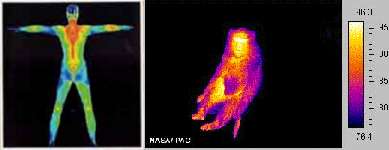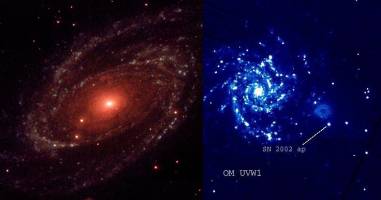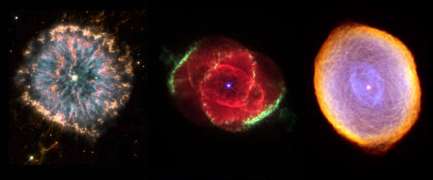


This region is sometimes known as the heat region because the infra-red region contains thermal radiation. You may well have seen pictures from thermal imaging cameras before on television programmes about the emergency services for example.

A thermal imaging camera detects heat from bodies. The various temperatures are displayed here in a false colour display with white being the hottest down to blue for the coldest.
The infrared region of the spectrum covers a temperature range of ten to a few thousand Kelvin. The human body emits temperatures in the range of around
It is important that the various components on the XMM telescope are kept within certain temperature ranges for them to operate correctly. The satellite receives heat radiation from the Sun and if this heat was not dealt with then XMM would overheat very quickly. XMM, as with most satellites used radiators to radiate thermal radiation away from the satellite to maintain an equilibrium with the radiation received from the Sun.
Optical region
This, as the name suggests, is the region of the spectrum which is visible to the human eye. It is in fact a very narrow portion of the whole spectrum just 300 nm wide (300 x 10-9m). It coincides with the wavelength of light from the Sun which is emitted at the greatest intensity, therefore you can see that is why the eye has evolved to be sensitive to such wavelengths.
The visible spectrum is commonly memorised using the sequence ROYGBIV although it is becoming more common in the scientific community to exclude the I as indigo is not distinguished as a separate colour.
It may be surprising to know the temperatures required to produce optical light. The temperature range is from around 4000 K to 7000 K. The Sun's surface temperature is abut 5800 K and so it emits light strongest at around 500 nm.
The XMM telescope obtains optical images of objects as well as X-ray images. This is achieved using the optical monitor

Images obtained by the optical monitor on board the XMM telescope
The major advantage of having optical instruments in space is that the images they obtain are not affected by the blurring effect of the Earth's atmosphere. The Hubble space telescope has given us perfect examples of clear images of many distant objects time and time again.

These are images of nebulae taken by the Hubble Space Telescope
|
|
|

